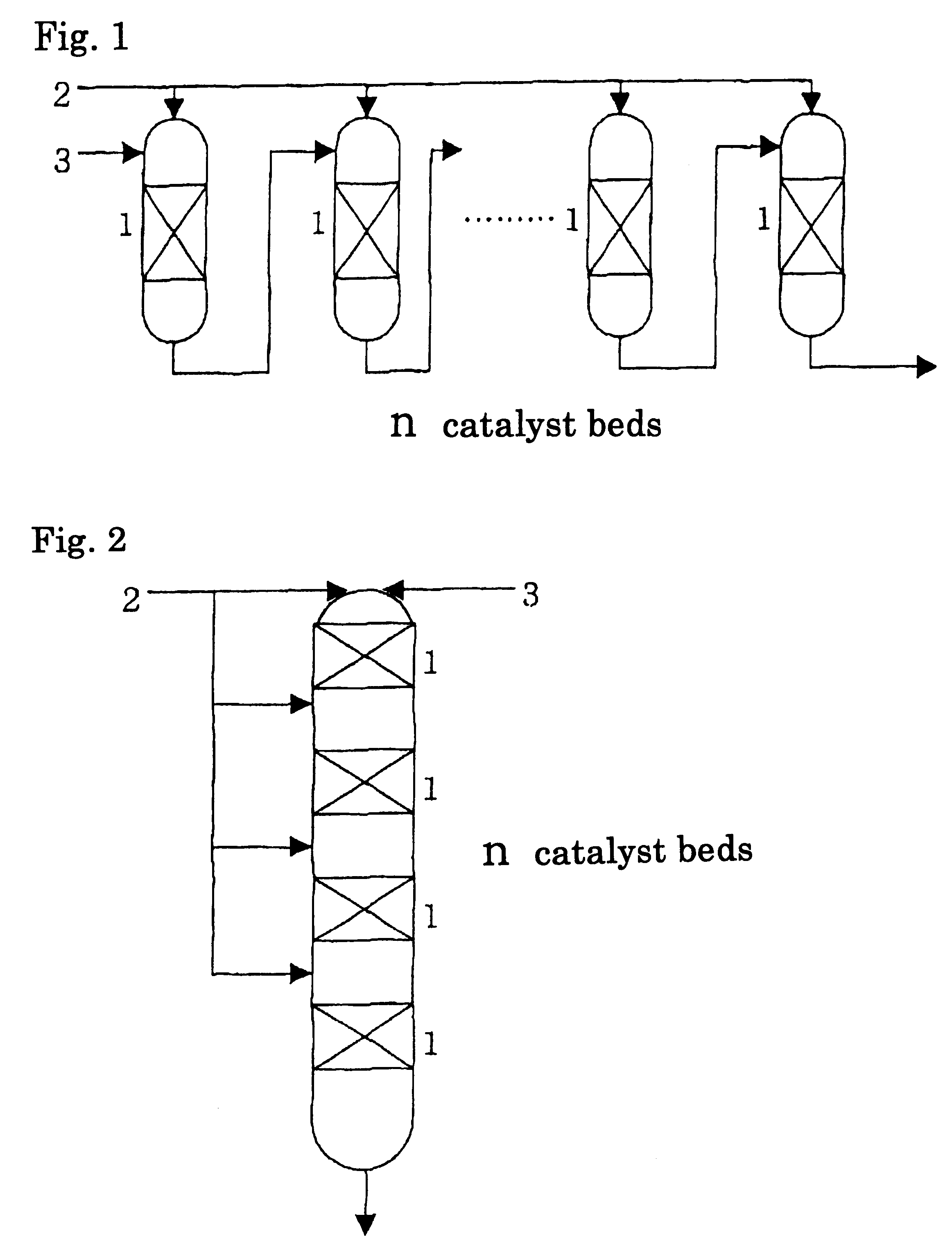The condition (4) is to supply the reaction mixture discharged from each outlet of respective catalyst beds excluding the final catalyst bed to the inlet of the subsequent catalyst bed (see FIG. 1 and FIG. 2). In other words, the reaction mixture discharged from an outlet of a catalyst bed serially passes through catalyst bed(s) in order. Apart of the reaction mixture discharged from an outlet of a catalyst bed may be recycled to the inlet of the same catalyst bed insofar as the effect of the invention is not deteriorated. This is effective for preventing a rise in temperature caused by the heat of reaction in the catalyst bed.
is not deteriorated. This is effective for preventing a rise in temperature caused by the heat of reaction in the catalyst bed.
By satisfying the above-described conditions, the present invention realizes the effect that a runaway of reaction accompanied by generation of heat can be prevented and an oxirane compound can be stably produced with high yield. In other words, it allows suppression of lowering in the catalyst activity by thermal deterioration, shortening of the catalyst life, lowering in the yield, runaway of the reaction and the like due to generation of heat accompanied by the reaction of ethylbenzene hydroperoxide and an olefin. Since the epoxidation reaction between ethylbenzene hydroperoxide and an olefin generates very abundant heat and is highly temperature-dependent, the reaction has a high danger of reaction runaway. Generally, the amount of reaction has been adjusted by controlling the temperature at the inlet of the catalyst bed or by compulsorily removing heat from the outside. However, it has become difficult to set the reaction temperature with accuracy according to the activity of a specific catalyst owing to a change in the catalyst activity with time or difference in time between the outlet and the inlet of the reactor, and therefore, not only problems arises that the activity of the catalyst is lowered and the yield decreases due to sudden increase in the amount of reaction and outflow of unreacted organic peroxide, but also there is a problem in stable operation. According to the present invention, the rise in temperature by the heat of the reaction can be controlled by partitioning the catalyst bed and adjusting feeding amount to respective catalyst beds; therefore, it becomes possible to prevent lowering in the catalyst activity and decrease in the yield accompanied by sudden rise in temperature in the catalyst bed, and additionally, the runaway of the reaction by a rise in the reaction temperature. In the present invention, a heat-removing apparatus such as a heat exchanger may be equipped between catalyst beds. This allows control of the temperature at the inlet of each catalyst bed, and together with the control of feeding amount of ethylbenzene hydroperoxide, provides double-safety and -steady operation.
Furthermore, a catalyst bed without a feed of fresh ethylbenzene hydroperoxide may be placed subsequent to the last divided catalyst bed. This is effective for treating unreacted ethylbenzene hydroperoxide in the reaction mixture discharged from the outlet of the last catalyst bed.
The epoxidation temperature is generally 0 to 200.degree. C. and preferably 25 to 200.degree. C. The pressure may be any pressure sufficient to keep liquid state of the reaction mixture. Generally, the pressure is advantageously 100 to 10,000 kPa. The amount of an olefin fed is 1 to 100 times, preferably 3 to 50 times, more preferably 5 to 20 times, based on the total molar number of ethylbenzene hydroperoxide fed to catalyst beds. Usually, unreacted olefin is recycled after separation and purification and used as the raw material for the epoxidation reaction.
In a specific example of the reaction, a case wherein propylene oxide is produced from propylene and ethylbenzene hydroperoxide is described below. The reaction can be carried out in a liquid phase using a solvent. The solvent is a liquid at the temperature and the pressure of the reaction and must be substantially inert to the reactants and the product. The solvent may be composed of a substance existing in a solution of ethylbenzene hydroperoxide actually used. Usually, the concentration of ethylbenzene hydroperoxide is 5 to 50% by weight and preferably 10 to 40% by weight. When, for example, it is a mixture with ethylbenzene as the raw material, said material may be used for a solvent without adding a solvent in particular. Other useful solvents include monocyclic aromatic compounds (e.g. benzene, toluene, chlorobenzene, o-dichlorobenzene), alkanes (e.g. octane, decane, dodecane) and the like. When a titanium-containing silicon compound catalyst is used as the catalyst, propylene oxide is obtained at a reaction pressure of 1 to 10 MPa and a reaction temperature of 50 to 150.degree. C. with a feed of 1 to 20 times by mole of propylene based on the molar amount of fresh ethylbenzene hydroperoxide fed. Unreacted propylene is recycled to the epoxidation step after separation and purification, and reused.
 Login to View More
Login to View More 

